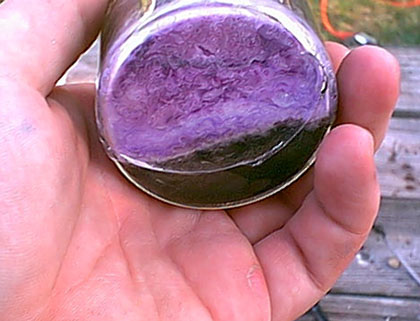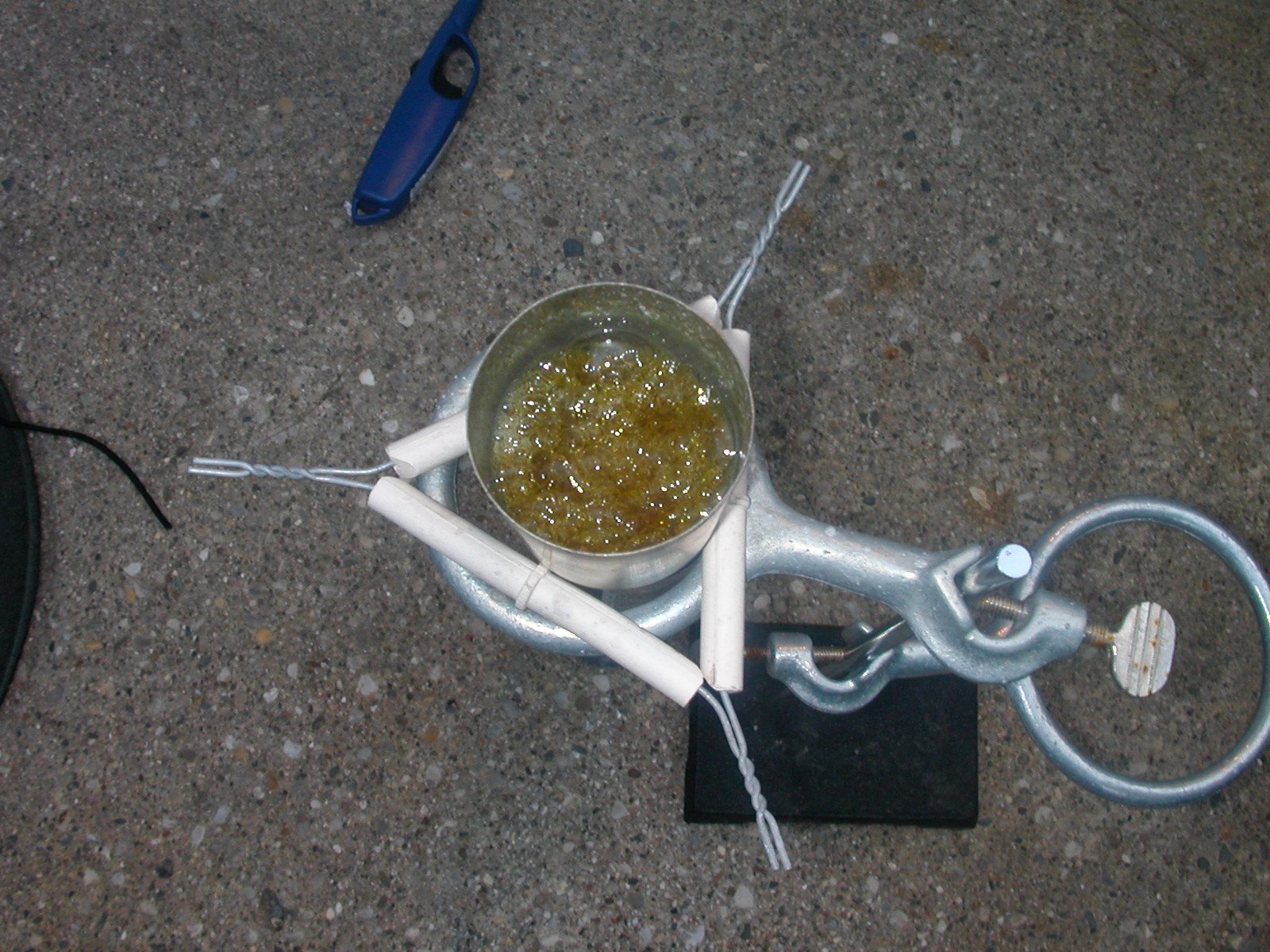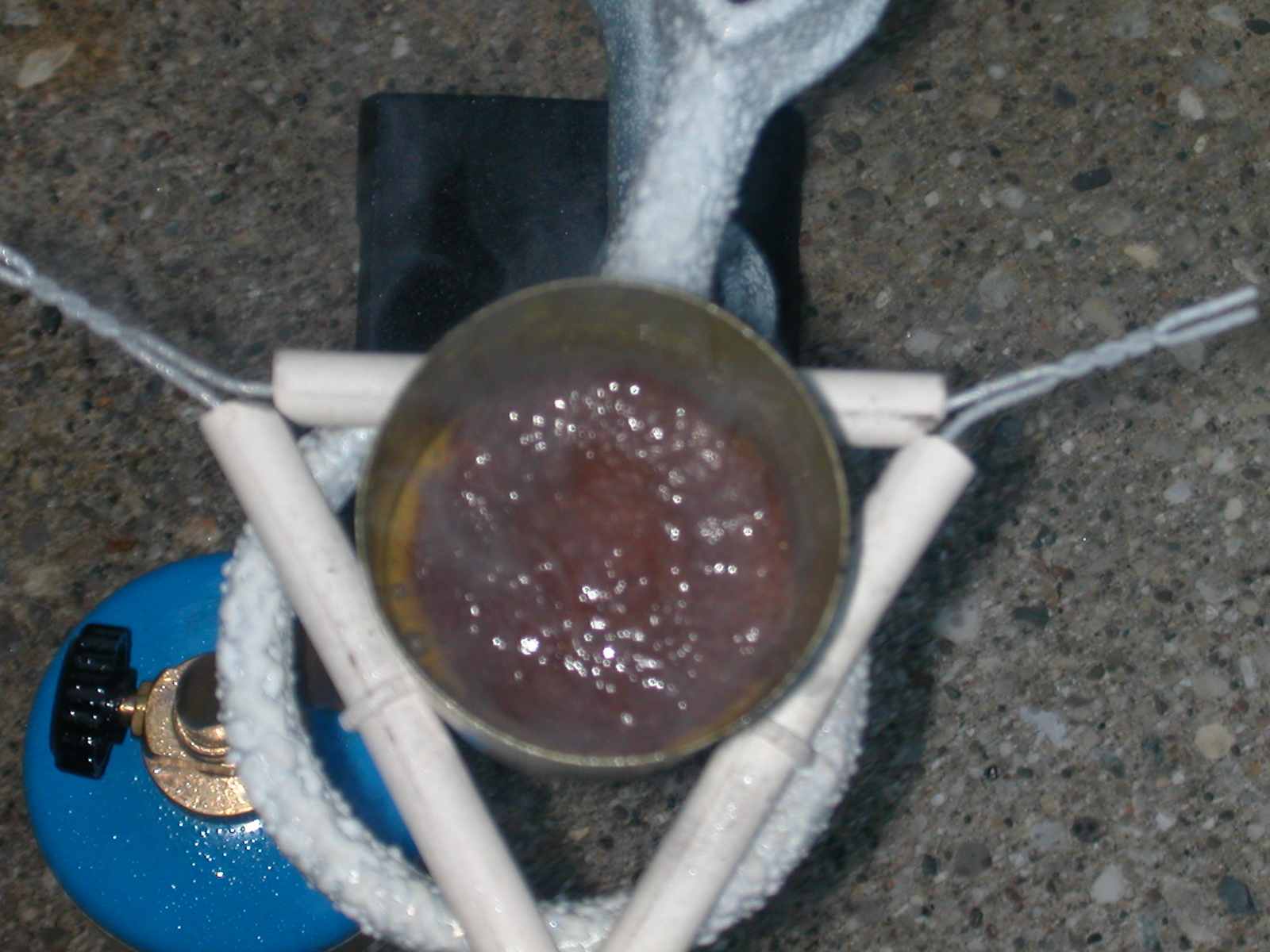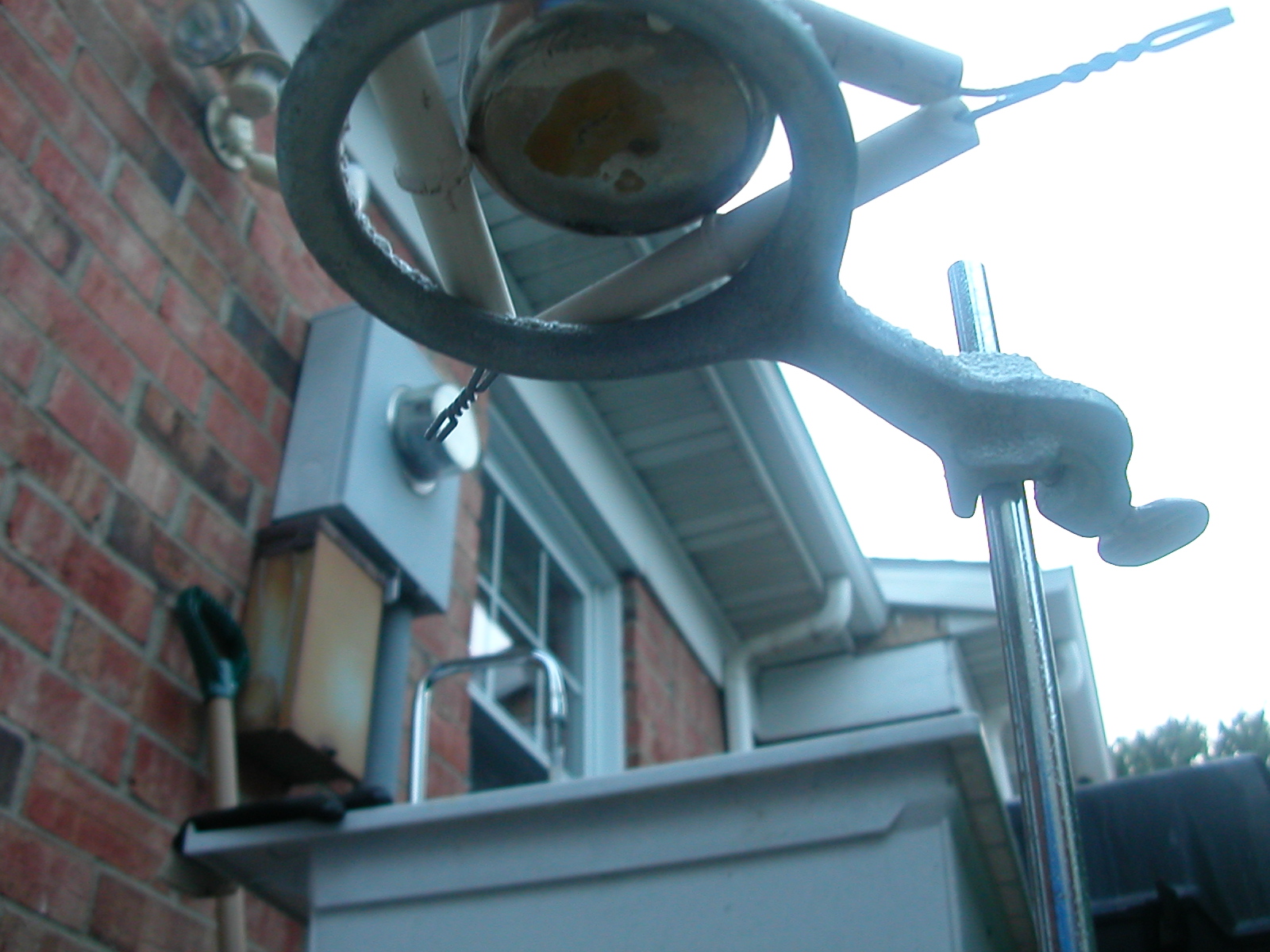| Pages:
1
2
3 |
simply RED
Hazard to Others
  
Posts: 209
Registered: 18-8-2005
Location: noitacoL
Member Is Offline
Mood: booM
|
|
(HPO3)n Dehydrating agent (polyphosphoric or metaphosphoric acid)
From "Inogranic chemistry - by Dobri Lazarov"
----------
Diphosphoric acid is synthesized by heating the orto-acid to 215 degrees C.
2H3PO4 = H4P2O7 + H2O
If you heat H3PO4 to 316 degrees C, metaphosphoric acid is synthesized. It exists in cyclic and polymeric forms and has the brute formula HPO3.
--------------
HPO3 is very strong dehydrating agent that could be used instead of acetic anhydride in RDX, HMX, TNT and other synthesis.
It could be possible to prepare HPO3n from normal 85% H3PO4 (1,5 dolars per liter) by heating (could it be concentrated to 100% by heating?).
Then 100% H3PO4 (melting point 42,3 degrees C) will be heated slowly to 316 C (electric stove will work).
Anyway it is unclear how long it must be heated to the upper temperature. To get 95% + yield ot HPO3n.
E.b.C: Title
[Edited on 4-9-2005 by chemoleo]
When logic and proportion have fallen sloppy dead...
|
|
|
simply RED
Hazard to Others
  
Posts: 209
Registered: 18-8-2005
Location: noitacoL
Member Is Offline
Mood: booM
|
|
Additional info from another source:
phosphoric acid
The most common, orthophosphoric acid, H3PO4, is usually simply called phosphoric acid. Two molecules of it are formed by adding three molecules of
water, H2O, to one molecule of phosphorus pentoxide (phosphoric anhydride, P2O5). It occurs as rhombic crystals or as a viscous liquid; both are
deliquescent. The crystals melt at about 42°C. It has specific gravity 1.834 at 18°C, is soluble in alcohol, and is very soluble in water. It is a
tribasic acid and forms orthophosphate salts with either one, two, or all three of the hydrogens replaced by some other positive ion. When it is
heated to about 225°C, it dehydrates to form pyrophosphoric acid, H4P2O7; at still higher temperatures metaphosphoric acid, HPO3, is formed.
When logic and proportion have fallen sloppy dead...
|
|
|
BromicAcid
International Hazard
    
Posts: 3244
Registered: 13-7-2003
Location: Wisconsin
Member Is Offline
Mood: Rock n' Roll
|
|
From Hawley's Condensed Chemical Dictionary:
| Quote: | Pyrophosphoric acid
Derivation: By heating phosphoric acid at 250-260C. Further heating produces metaphosphoric acid.
Phosphoric acid, meta- (HPO<sub>3</sub> <sub>x</sub> <sub>x</sub>
Derivation: By heating ortophosphoric acid to redness, by treating phosphorus pentoxide with a calculated amount of water, by heating diammonium
phosphate.
Use: Phosphorylating agent, dehydrating agent, dental cements, labratory reagent. |
Sounds easy, phosphoric acid is non-volitile, just crank up the heat. What are you going to do it in, clay?
Edit: Posted simultaneously with simply RED
[Edited on 9/4/2005 by BromicAcid]
|
|
|
chloric1
International Hazard
    
Posts: 1140
Registered: 8-10-2003
Location: GroupVII of the periodic table
Member Is Offline
Mood: Stoichiometrically Balanced
|
|
here is the real problem. No silicates! Hot 85% H3PO4 dissolves porcelin, (Cannot spell). This would also include most clays, glass, and even alumina
because this forms aluminum phosphate. If platinum curcibles are out of question,maybe hastleoy or Inconel might work. I here 914 stainless is
supposed to be phosphoric acid resisitant but not absolutely positive on this.
Fellow molecular manipulator
|
|
|
neutrino
International Hazard
    
Posts: 1583
Registered: 20-8-2004
Location: USA
Member Is Offline
Mood: oscillating
|
|
While it is true that hot phosphoric acid will eat glass, this is a very slow process. Boiling your acid in a glass beaker shouldn't be too
problematic.
|
|
|
Polverone
Now celebrating 21 years of madness
        
Posts: 3186
Registered: 19-5-2002
Location: The Sunny Pacific Northwest
Member Is Offline
Mood: Waiting for spring
|
|
If phosphoric acid dissolves glass, it does so only to a minor extent. I have heated phosphoric acid to red heat in test tubes and not noticed any
effects beyond the normal test tube damage that comes with thermal abuse. I have also heated phosphoric acid to the point that it formed a solid and
the pyrex was melting around it.
I have heated diammonium phosphate in ordinary soda glass until it melted and then considerably thickened. I was able to draw it out in long strongs
that went brittle like glass as it cooled. The glass vessel cracked on cooling, but there was no other damage visible. The solid material was quite
hygroscopic, rapidly growing sticky on its surface.
In any case, I think you will have little trouble heating phosphoric acid to 316 C in glass, but I would suggest using something expendable as you may
crack the glass on cooling.
PGP Key and corresponding e-mail address
|
|
|
Nicodem
Super Moderator
      
Posts: 4230
Registered: 28-12-2004
Member Is Offline
Mood: No Mood
|
|
Making pyrophosphoric acid (H4P2O7) from H3PO4 is no problem. Once I was about to follow the procedure in Organikum which states that you have to heat
85% H3PO4 at 150°C under vacuum for 6h, but since it seamed to me that this takes too much time I heated to 200-250°C untill the weight of the
liquid fell at the theoretic amount for the H4P2O7 composition (about 2-3h). No glass etching was noted and the resulting poliphosphoric acid is a
very viscious liquid (it gets a bit dark, perhaps from impurities in H3PO4).
However I doubt that heating it more would result in the formation of 'HPO3' in a fast process. It may take many hours at >300°C in
vacuum. Not really practical I guess.
…there is a human touch of the cultist “believer” in every theorist that he must struggle against as being
unworthy of the scientist. Some of the greatest men of science have publicly repudiated a theory which earlier they hotly defended. In this lies their
scientific temper, not in the scientific defense of the theory. - Weston La Barre (Ghost Dance, 1972)
Read the The ScienceMadness Guidelines!
|
|
|
simply RED
Hazard to Others
  
Posts: 209
Registered: 18-8-2005
Location: noitacoL
Member Is Offline
Mood: booM
|
|
Pyrophosphoric acid is also not bad as RDX synth. media.
HPO3 mixed with CH3COOH has been used to extract vitamine C in some analytical cases.
Do you know the physical properties of HPO3 and H3PO4, P2O5, HPO3, H4P2O7 solubility in diethyl ether?
When logic and proportion have fallen sloppy dead...
|
|
|
garage chemist
chemical wizard
    
Posts: 1803
Registered: 16-8-2004
Location: Germany
Member Is Offline
Mood: No Mood
|
|
(HPO3)n is a real kickass dehydrating agent, stronger than oleum for example. It dehydrates H2SO4 to SO3, look at the procedure I posted in the
"oleum and SO3" thread.
Now, let's talk about its preparation.
Its ability to attack glass in the hot stage is a problem.
As I found out today, it attacks also iron very badly, a lot of hydrogen is evolved and the crucible started to dissolve!
Then I used a quartz crucible, and incredibly, it was also attacked!  
However, the attack was much less severe than with glass. My beaker in which I did the first preparation got attacked considerably, and the walls are
now noticeably thinner.
On the contrary, the walls of my quartz crucible now feel as if they were a bit THICKER. Maybe the quartz forms some sort of protective layer after
some time which prevents further attack.
For the next batches of (HPO3)n, I'll use my quartz crucible.
I have yet to try my nickel crucible. This will also be one of the next experiments.
Does anyone know what kind of reaction is responsible for the attacking of quartz?
If someone finds out which metal is resistant to hot 85% H3PO4 and also to (HPO3)n at red heat, please post it here.
|
|
|
BromicAcid
International Hazard
    
Posts: 3244
Registered: 13-7-2003
Location: Wisconsin
Member Is Offline
Mood: Rock n' Roll
|
|
Couldn't copper be used, it is only attacked by sulfuric at high temperatures due to the oxidizing power of that acid at those temperatures,
however phosphoric being even less oxidizing should work for this. Copper endcaps for pipe work are highly avalible, I will try to boil down
phosphoric acid in copper on Tuesday unless someone else gives it a shot first.
|
|
|
catfish
Harmless

Posts: 7
Registered: 28-8-2005
Member Is Offline
Mood: high on life
|
|
polyphosphoric acid
hey all, just wondering where this could be obtained, since it's not on the lists in the reagent/ acquisition forum.
Or made.
Thx in advance.
|
|
|
BromicAcid
International Hazard
    
Posts: 3244
Registered: 13-7-2003
Location: Wisconsin
Member Is Offline
Mood: Rock n' Roll
|
|
When looking for a chemical avalible OTC that is not on a list, you can try the Household Products Database in which you can enter a chemical name and get a list of products that contain it, polyphosphoric acid only appearing
in one of the listings.
Is polyphosphoric acid not just metaphosphoric acid? Metaphosphoric acid having the formula (HPO<sub>3</sub> <sub>x</sub> due to it being a polymer type substance of
HPO<sub>3</sub> units (Is there a sharp distinction between the two?). I noticed you already posted a similar question in the thread
dedicated to the manufacture of that substance, and as such I really don't see why you started this thread. <sub>x</sub> due to it being a polymer type substance of
HPO<sub>3</sub> units (Is there a sharp distinction between the two?). I noticed you already posted a similar question in the thread
dedicated to the manufacture of that substance, and as such I really don't see why you started this thread.
Upon looking up polyphosphoric acid in my chemistry dictionary I find that it is just a mixture of acids, e.g., dehydrated phosphoric acid
containing phosphoric, pyrophosphoric, and metaphosphoric acids in different concentrations, so kind of like a commerical mixture that is sold for
various purposes, polyphosphoric is denoted as having a H<sub>3</sub>PO<sub>4</sub> precentage of 115% technically. So you
can just heat phosphoric acid to make it. I don't know where this would be OTC, but phosphoric is avalible enough in most places.
|
|
|
catfish
Harmless

Posts: 7
Registered: 28-8-2005
Member Is Offline
Mood: high on life
|
|
Bromic, thx for answering...the reason I started another thread was because the old one was deleted somehow.
I can get phosphoric acid no problem...could you point me in the direction of some more concrete temps...?
Thx again.
|
|
|
Nicodem
Super Moderator
      
Posts: 4230
Registered: 28-12-2004
Member Is Offline
Mood: No Mood
|
|
There already is a thread discussing the production of polyphosphoric acid:
https://sciencemadness.org/talk/viewthread.php?tid=4409
And if you would have read it you would see that there already are described the needed conditions for making polyphosphoric acids of various
concentrations. In my post there, for example, I described how to make the pyrophosphoric acid in a very simple way(polyphosphoric with the 78%
concentration if expresed as P2O5 - a concentration convention often used in literature). The comercial PP is usually of a bit higher concentration
(usually 83% P2O5 or more).
…there is a human touch of the cultist “believer” in every theorist that he must struggle against as being
unworthy of the scientist. Some of the greatest men of science have publicly repudiated a theory which earlier they hotly defended. In this lies their
scientific temper, not in the scientific defense of the theory. - Weston La Barre (Ghost Dance, 1972)
Read the The ScienceMadness Guidelines!
|
|
|
garage chemist
chemical wizard
    
Posts: 1803
Registered: 16-8-2004
Location: Germany
Member Is Offline
Mood: No Mood
|
|
A new idea.
Can (HPO3)n dehydrate amides to nitriles?
If yes, we could make our own acetonitril from acetamide (which in turn can be made from ethyl acetate and ammonia, see frogfots page).
Or if we have a good fume hood, we could dehydrate formamide (easily produced from ethyl formate and ammonia) to hydrogen cyanide and use that to make
extra-pure NaCN and KCN.
|
|
|
ADP
Hazard to Others
  
Posts: 120
Registered: 4-4-2005
Location: USA
Member Is Offline
Mood: Productive
|
|
About the preparation of pyrophosphoric acid:
If one obtains 85% H3PO4 and dehydrates by boiling, what temperature is favorable for this? I know that H3PO4 has a BP of 158*C, Would I then not want
to heat to the boiling point? Wouldn't the H3PO4 start boiling away faster than it would become pyrophosphoric acid? I know that the first post
states 210*C. Also how long must this temp be held to know when a full conversion has been obtained? When it stops fuming H2O?
|
|
|
12AX7
Post Harlot
    
Posts: 4803
Registered: 8-3-2005
Location: oscillating
Member Is Offline
Mood: informative
|
|
Apparently the boiling only refers to the water content (like how hydrated salts melt at a temperature then dry out).
Seems pretty Easy to me, just heat the junk up to red heat for an hour or so, maybe in a cordierite boat since it's more refractory and lower in
shrinkage than cheap glass.
Tim
|
|
|
ADP
Hazard to Others
  
Posts: 120
Registered: 4-4-2005
Location: USA
Member Is Offline
Mood: Productive
|
|
True, after reading some, in this case yes it is nessecary to heat to 215dC but at some point, H3PO4 will evaporate after boiling, but just not as
fast as it will dehydrate at this temperature.
|
|
|
ADP
Hazard to Others
  
Posts: 120
Registered: 4-4-2005
Location: USA
Member Is Offline
Mood: Productive
|
|
In my Chemistry textbook entitled: Chemistry by Steven S. Zumdahl, It states: | Quote: | | Phosphoric acid easily undergoes condensation reactions, where a molecule of water is eliminated in the joining of two molecules of
acid. |
It then goes on to show two molecular diagrams of H<sub>3</sub>PO<sub>4</sub> -->
H<sub>4</sub>P<sub>2</sub>O<sub>7</sub>. Then it states "The product is called pyrophosphoric acid.
Further heating produces polymers, such as tripolyphosphoric acid." And it gives the nomenclature
H<sub>5</sub>P<sub>3</sub>O<sub>10</sub>. Where does metaphosphoric acid come from in all of this? And how does
this stucture form?
|
|
|
BromicAcid
International Hazard
    
Posts: 3244
Registered: 13-7-2003
Location: Wisconsin
Member Is Offline
Mood: Rock n' Roll
|
|
Today I heated ammonium phosphate at high temperatures (But how to convert ammonium phosphate to diammonium phosphate? Oxalic acid?) Anyway, it
heated nicely giving off lots of ammonia and turning some very pretty colors, I noticed that in the hottest areas of the vessel it turned white, upon
cooling the vessel cracked, included is a picture of it, very pretty.
Also, I tried to make phosphoric acid via the wet method today, 185 ml of conc (~16 M) H<sub>2</sub>SO<sub>4</sub> was
dilluted with 30 ml of distilled water and with stirring to 310 grams of bone ash Ca<sub>3</sub>(PO<sub>4</sub> <sub>2</sub> was added. So one mole of calcium phosphate to 3 mol sulfuric
acid, stoichiometric quantites. At first things mixed well but there was quite a bit of heat generated, and after half of the bone ash was added I
had a paste, after all of it was added I had solid (that gave off fumes that smelled like HCl). I added 100 ml of water and later another 50 ml of
water and in the end I had a thin water layer. <sub>2</sub> was added. So one mole of calcium phosphate to 3 mol sulfuric
acid, stoichiometric quantites. At first things mixed well but there was quite a bit of heat generated, and after half of the bone ash was added I
had a paste, after all of it was added I had solid (that gave off fumes that smelled like HCl). I added 100 ml of water and later another 50 ml of
water and in the end I had a thin water layer.
I allowed to settle overnight and the next day I filtered the whole mess in sections, giving me nearly 300 ml of liquid. The liquid was boiled down
to 40 ml of black foul smelling liquid, with obvious sulfuric acid content (it gave off white fumes cause I heated it too high).
Overall I consider the wet process a failure, I will try it with more dillute sulfuric in the future. Anyway, I tried to make some metaphosphoric
acid today, but failed, failed to get the inital phosphoric and broke my beaker for my other attempt, better luck next week right 
BTW, ADP, I have a similar entry in my book Descriptive Inorganic Chemistry third edition. It is obvious to see how the structure of metaphosphoric
acid forms just from the way you explain things.
3(HO)<sub>3</sub>PO ---> (HO)<sub>2</sub>PO-P(OH)O-OP(HO)<sub>2</sub>
That would be the tripolyphosphoric acid, now look at it, the center P is the repeating unit in metaphosphoric acid, all metaphosphoric acid is, is
this process reapeating itself until these chains are really long, thereby giving the repeating unit of these polymers.

|
|
|
chloric1
International Hazard
    
Posts: 1140
Registered: 8-10-2003
Location: GroupVII of the periodic table
Member Is Offline
Mood: Stoichiometrically Balanced
|
|
Equipment failure
| Quote: | Originally posted by BromicAcid
Couldn't copper be used, it is only attacked by sulfuric at high temperatures due to the oxidizing power of that acid at those temperatures,
however phosphoric being even less oxidizing should work for this. Copper endcaps for pipe work are highly avalible, I will try to boil down
phosphoric acid in copper on Tuesday unless someone else gives it a shot first. |
You would think that a copper would hold up but...BIG but here. Thinking nickel was less easily corroded than copper even though it is able to
displace hydrogen, I decided on trying to heat the acid in this. Whoa! Big mistake. As soon as it reached boiling temp it was green turning yellow.
then the liquid turned orange red upon further heating. Finally as I removed the flame to see if it would solidify, the phosphoric acid had eaten all
the way through!! Well, that was $11 wasted. Nickel crucibles are still easy to come buy so I will buy another. I can't figure out the reddish
color except I remember reading certain trivalent nickel complexes are red. any thoughts on this? So, I guess I can try copper but I am quite
doubtfull. Looks like quartz is the only option.

Fellow molecular manipulator
|
|
|
chloric1
International Hazard
    
Posts: 1140
Registered: 8-10-2003
Location: GroupVII of the periodic table
Member Is Offline
Mood: Stoichiometrically Balanced
|
|
red oxidation product
I have a couple pics coming

Fellow molecular manipulator
|
|
|
chloric1
International Hazard
    
Posts: 1140
Registered: 8-10-2003
Location: GroupVII of the periodic table
Member Is Offline
Mood: Stoichiometrically Balanced
|
|
crucible failure
Cannot believe this! A weak acid tearing up nickel!

Fellow molecular manipulator
|
|
|
BromicAcid
International Hazard
    
Posts: 3244
Registered: 13-7-2003
Location: Wisconsin
Member Is Offline
Mood: Rock n' Roll
|
|
Jeeze.... terrible, I would have never expected it. The outlook for copper doesn't look good either, I looked up the resistance of copper and
other alloys online to phosphoric acid at 120C and 75% concentration and none of them were really good (except an aluminum/copper alloy), copper
wasn't even listed as having a good resistance at room temperature but I will still try it.
Recently I was looking through the "Complete Treatise of Chemistry" series at the entry for metaphosphoric acid and it states that gold is
the prefered crucible material of choice for this reacion and that it is prefered as even platinum is attacked! It also lists several forms of
metaphosphoric acid that can be made and the preparation of each, listing the metaphosphoric acid generated by heating orthophosphoric acid to red
heat and hold it there as having the greatest dehydrating power.
I bought some naval jelly (at great expense) and I will try to do some things with copper and maybe some other metals but the outlook is not good.
|
|
|
12AX7
Post Harlot
    
Posts: 4803
Registered: 8-3-2005
Location: oscillating
Member Is Offline
Mood: informative
|
|
If you can pour it out while glowing (it's like fused glass, right?), I don't see why a ceramic crucible wouldn't work. If silica
isn't soluble, I doubt aluminosilicates would be very soluble. High-alumina crucibles should have less shrinkage than the acid, too, preventing
cracking.
Tim
|
|
|
| Pages:
1
2
3 |